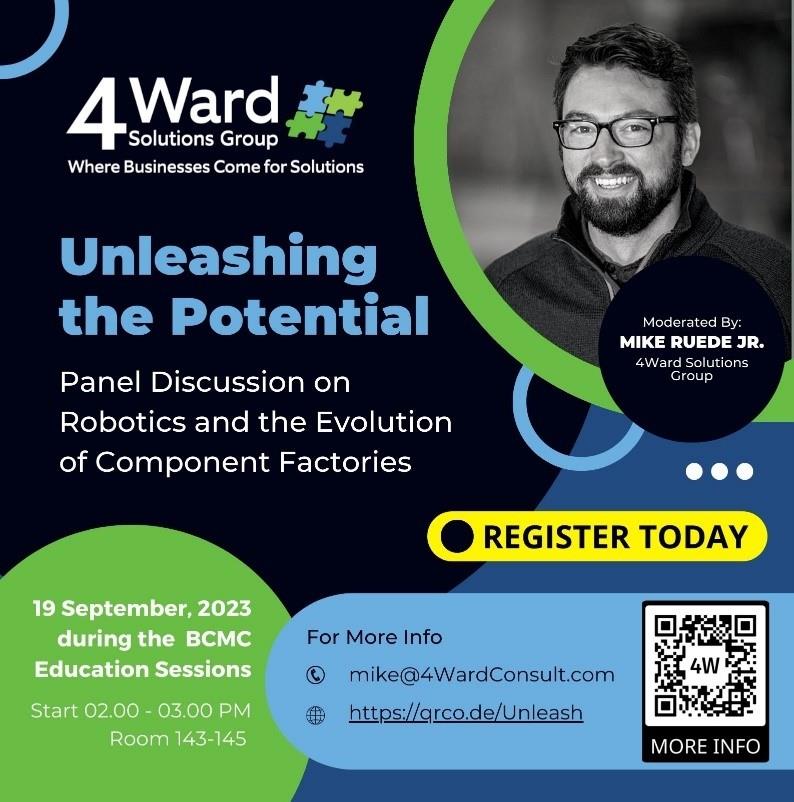4Ward Solutions Group Leads Robotics and Automation Panel During BCMC | FS
Originally Published by: 4Ward Solutions Group — August 25, 2023
SBCA appreciates your input; please email us if you have any comments or corrections to this article.
This year, you can start your BCMC experience with an exciting panel discussion led by 4Ward Solutions Group that features four of today’s most significant robotics manufacturers: House of Design, Trussmatic, Brave Control Systems, and Randek. The panel discussion will take place Tuesday, September 19th at 2 pm in room 143–145 at the Indianapolis Convention Center. Not registered for BCMC yet? Register onsite in Indianapolis.
 The landscape of industry and manufacturing is undergoing a profound transformation, powered by the relentless advancement of robotics and automation technologies. The integration of robotics into these sectors has proven to be a game-changer, revolutionizing processes, optimizing efficiency, and unlocking new possibilities. The amalgamation of cutting-edge technology with traditional manufacturing has given birth to a new era, where robotics present an affordable solution for the building industry, and the term "smart factory" has become more than just a buzzword.
The landscape of industry and manufacturing is undergoing a profound transformation, powered by the relentless advancement of robotics and automation technologies. The integration of robotics into these sectors has proven to be a game-changer, revolutionizing processes, optimizing efficiency, and unlocking new possibilities. The amalgamation of cutting-edge technology with traditional manufacturing has given birth to a new era, where robotics present an affordable solution for the building industry, and the term "smart factory" has become more than just a buzzword.
 How will your operations meet the demands of capacity and labor shortages? This panel discussion will give you the chance to hear from our industry’s leading experts in robotics. Mike Ruede, Jr., 4Ward Automation Solution Expert, will moderate this discussion and share invaluable information for developing your unique strategy.
How will your operations meet the demands of capacity and labor shortages? This panel discussion will give you the chance to hear from our industry’s leading experts in robotics. Mike Ruede, Jr., 4Ward Automation Solution Expert, will moderate this discussion and share invaluable information for developing your unique strategy.
The Current State of Robotics in Industry
The use of robotics in building and manufacturing is no longer a distant dream; it's a vibrant reality. From automotive assembly lines to complex construction sites, robots have found their place, delivering precision, consistency, and speed that often surpass human capabilities. The current generation of industrial robots is versatile, capable of handling intricate tasks that were once considered beyond the scope of automation.
Robotic arms equipped with sensors and cameras can perform delicate tasks such as placement of chords and studs, installation of sub-assemblies, and quality control with unparalleled accuracy. In the construction sector, drones are equipped with imaging technology to survey construction sites, monitor progress, and even assist in designing structures. Beyond efficiency, our industry will also reap major safety benefits available through robotics.
The Future Path of Robotics
As technology evolves, so does the potential. The future promises even more groundbreaking innovations. The concept of a lights-out factory, where production is entirely automated and operates without human intervention, is gradually becoming a reality. Robots can work tirelessly around the clock, reducing production times and maximizing output. As we drive our manufacturing forward to meet the needs of offsite manufacturing, we can utilize robotics to handle many of the additional processes, such as installation of MEP products into wall panels.
The reach of robotics extends beyond the conventional assembly line or construction site. Robots are finding applications in areas previously unexplored. Warehouses are embracing automated systems for inventory management and order fulfillment. Autonomous vehicles are enhancing material transport within factories, reducing human labor and improving efficiency.
One of the most intriguing prospects is the integration of robotics with augmented reality (AR) and virtual reality (VR). These immersive technologies allow workers to visualize complex tasks, receive realtime instructions, and even remotely control robots. This convergence of robotics and digital tools is redefining human-machine interaction and reshaping the way work is accomplished.
 Discovering Metrics and Determining the Impact of Robotics
Discovering Metrics and Determining the Impact of Robotics
The introduction of robotics is not a mere change in tools; it's a transformation of processes and dynamics. To move efficiently toward the next phase of this transformation, we must establish the right metrics. The clearer the goal, the faster the progress. Manufacturers and builders need to identify key performance indicators (KPIs) that can accurately measure the impact of robotics on their operations. We as an industry have to fundamentally change our thinking around labor and how we track. The days of “labor-hours” and “labor-minutes” or “work minutes”, as some would say, is an archaic methodology that isn’t serving us well.
Metrics may include production efficiency, defect rates, downtime, energy consumption, and labor cost savings. These measurements provide concrete insights into how robots are optimizing processes and contributing to the bottom line. Regular analysis of these data points helps fine-tune the integration of robotics and aids in strategic decision-making.
 Challenges and Considerations
Challenges and Considerations
When implementing robotics, setting clear goals is crucial. The goals should align with the overall mission of the facility and address specific pain points. These objectives could range from increasing production output, reducing errors, enhancing product quality, or even creating a safer working environment for human workers.
Collaborative robots, referred to as cobots, exemplify the human-robot partnership. These robots are designed to work alongside humans, complementing their skills and augmenting their c pabilities. Cobots excel in scenarios where precision is essential, and repetitive tasks can be offloaded to machines, freeing up human workers to focus on higherlevel tasks that require creativity and critical thinking.
While the potential of robotics in the building industry is vast, challenges persist. The initial investment in robotics technology can be substantial, encompassing costs for hardware, software, training, and integration. Companies must weigh these costs against the long-term benefits, such as increased efficiency, reduced labor expenses, and improved quality.
Integration is another hurdle that requires careful consideration. Adapting existing processes to accommodate robotic systems may entail temporary operational disruptions while employees movethrough the learning curve. However, with proper planning, training, and change management, these challenges can be mitigated, and the transition can be smoother.
Collaboration for a Robotic Future
Embracing the potential of robotics necessitates collaboration among industry leaders and technology developers. These stakeholders need to work in synergy to create an environment conducive to innovation and growth. And just as our individual panelists have done, so whole industries can advance the cross-pollination of ideas and solutions.
Most importantly, the integration of robotics is more than a technical shift; it's a paradigm shift. It's about reimagining how we create, build, and produce. The current state of robotics is impressive, but the future holds even greater promises. By setting clear goals, embracing challenges, and fostering collaboration, we can truly unleash the potential of robotics, revolutionizing industries and propelling us into a new era of manufacturing excellence. To find out more about this exciting panel discussion at BCMC visit https://qrco.de/Unleash. Visit the 4Ward Solutions team at BCMC in booth 617.
4Ward Solutions Group is the innovative solutions provider for the building industry, that keeps your business at the leading edge of technology, manufacturing processes, and more. Ben Hershey is the CEO of 4Ward Solutions Group and their affiliated companies. A Past President of SBCA and owner of multiple manufacturing, distribution, and software companies, Ben and his team have provided unparalleled solutions for more than 30 years. Mike Ruede, Jr. is the Automation Solutions Expert for 4Ward and their affiliated companies. Mike's expertise in automation and robotics within offsite manufacturing and LBM industries offers immense value to organizations seeking enhanced efficiency and productivity.
